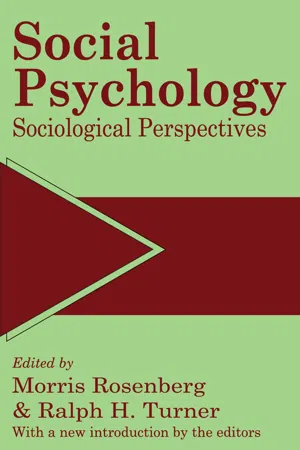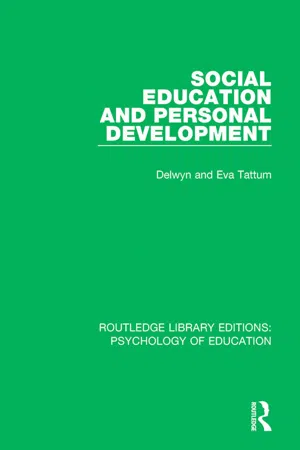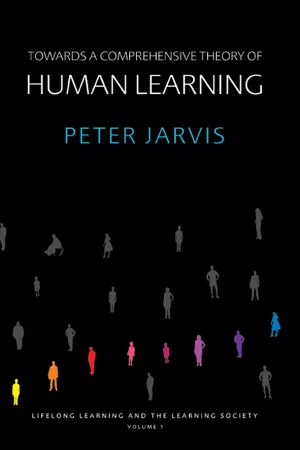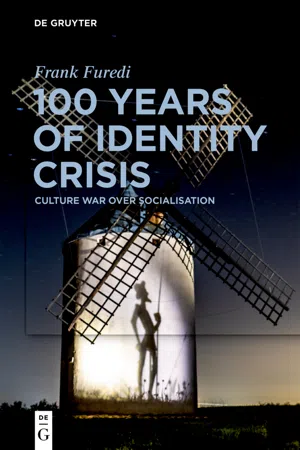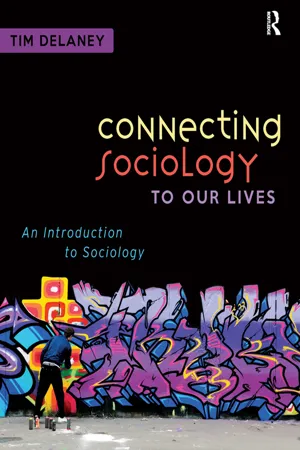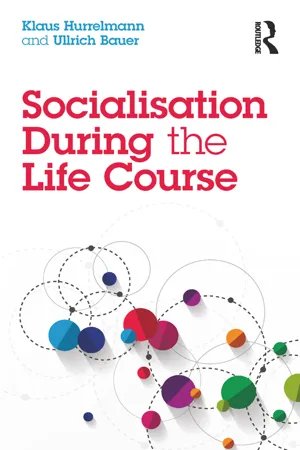Social Sciences
Socialisation
Socialization refers to the lifelong process through which individuals learn and internalize the values, norms, and behaviors of their society or culture. It occurs through interactions with family, peers, schools, media, and other social institutions, shaping an individual's identity and social roles. Socialization is crucial for the development of social skills, cultural understanding, and the formation of personal and collective identities.
Written by Perlego with AI-assistance
Related key terms
Related key terms
1 of 4
Related key terms
1 of 3
10 Key excerpts on "Socialisation"
- eBook - ePub
Social Psychology
Sociological Perspectives
- Ralph Turner(Author)
- 2017(Publication Date)
- Routledge(Publisher)
In keeping with their disciplinary origins, sociological definitions of socialization tend to emphasize the ways in which the individual learns to fit into society, and, to a lesser degree, how this process changes not only the individual but society as well. Many definitions make the point that processes of socialization vary immensely in terms of explicitness, formality, and specificity (Clausen 1968; Elder 1975), often depending on characteristics of the socializee such as age, the relationship between socializee and agent of socialization, and the context of socialization (see chapter 6). Virtually all sociological definitions of socialization emphasize the distinctly social nature of the processes of socialization. For sociologists, processes such as imitation, identification, and role acquisition are viewed as social interactions; the interaction is reciprocal and the socializee is not passive, but takes an active part in the process. Among sociologists, there seems to be substantial agreement that socialization serves to maintain social groups by promoting the adaptation of the individual to them; in this sense socialization is beneficial to both the individual and society. Sewell (1963) defines socialization as “processes by which individuals selectively acquire skills, knowledge, attitudes, values and motives current in the groups of which they are or will become members.” In this definition and in many others (Baumrind 1975; Zigler and Child 1969; Mortimer and Simmons 1978), socialization is a symbiotic process with some positive outcomes for both the social group and the individual. Likewise, those definitions that emphasize acculturation propose that socialization not only enables the socializee to adapt, but that it is the way in which culture and societies reproduce themselves (Inkeles 1968) - eBook - ePub
- Delwyn Tattum, Eva Tattum(Authors)
- 2017(Publication Date)
- Routledge(Publisher)
primary Socialisation takes place. Within the family structure there are different role players – mother, father, other children – with whom the newborn has to learn to interact. Not only does the infant learn his own role but he also has to learn the role requirements of the other family members, that is, he has to learn to take the role of each of the others. It follows that the child’s view of himself is heavily dependent on how other people respond to his behaviour. Eventually, the child begins to take the role of a much wider range of people outside the family context but into each new situation he takes a history of social experiences. It is this interplay between the historical dimension and situational dimension that results in each person’s unique social self.Thus it is during primary Socialisation that the child acquires a sense of identity – and a sense of location. Central to this process of knowing who we are is the means whereby children learn that they are reflexive beings; that is, they discover that they can communicate and talk to themselves in much the same way as they can communicate and talk to other people. In other words, Socialisation is the process whereby the individual becomes capable of talking to himself.To speak of acquisition of self is therefore to speak in the most basic sense of learning a language. The child is born into a community of speakers of a particular language, and thus is also born into a preexisting world of objects that are embedded in vocabulary and grammar. From the child’s point of view, these objects simply exist. As Alfred Lindesmith and Anselm Strauss have written, ‘… things have names … and names have things’. Every act of speech in which the child participates, whether as speaker or listener, brings him or her into contact with this world of objects, and it is the child’s task to discover what those objects mean. The child must not only learn the names of things, but also infer the ‘things of names’. - eBook - ePub
- Peter Jarvis(Author)
- 2012(Publication Date)
- Routledge(Publisher)
Experiential learning begins with response to our life-world and it is within this that our learning takes place and we will briefly examine a number of learning processes that occur within the life-world, including Socialisation and role making, developing self and identity, and acquiring language, knowledge and meaning. In a real sense these are all inter-related and any separation here is for heuristic purposes only – we will deal with them in the following sub-sections: primary Socialisation, secondary Socialisation, brainwashing and indoctrination and, finally, cultural and social capital.Primary Socialisation
Culture is an ambiguous concept that functions both externally and internally. When we are born into the world we have no cultural awareness, although we have learned a number of phenomena pre-consciously in the womb. At birth then, culture is external to us but internal to our significant others and through interaction with them we internalise (learn, often non-reflectively and unintentionally in the first instance) it. Once they have shared and we have learned the relevant knowledge, values, beliefs, etc. the culture becomes our own subjective reality and as such helps determine the way that we perceive and experience the world, and consequently we learn in it and from it. This is the process of Socialisation which Berger and Luckmann (1966 : 150) sub-divide thus:Primary socialization is the first socialization an individual undergoes in childhood, through which he [sic] becomes a member of society. Secondary socialization is any subsequent process which inducts an already socialized individual into new sectors of the objective world of his society.Crucial to this process is learning the language of the people since it is through language that meaning, knowledge and so on, are conveyed. Language is at the heart of the greater part of our conscious learning and it will always reflect the culture of our life-world, as many childhood educators have demonstrated. Language, as such, is arbitrary and symbolic; no word, thing or event has intrinsic meaning, and it only assumes meaning when meaning is given to it, which occurs through narrative that unites the disparate episodic events in our lives. Consequently young children grow up to learn the meaning of words, but the process is more complex than this. Let us assume that my young grandson is looking at the computer on which I am writing this chapter but he does not know that it is a computer, nor does he yet know the word ‘computer’, although he can see the object/instrument that I am using. In fact the computer has no meaning for him. As he looks at it, the sensations on his retina are transmitted to his brain and so he is aware of the image of the computer and he still has to learn the word. At the same time he has to learn to associate the word ‘computer’, a sound which is transmitted to his brain as sensations generated by the sounds he has heard. Eventually the visual and the sound sensations are linked in his mind and the object becomes a computer. He can then take the meaning of the word for granted – he has learned it non-reflectively, and it is almost as if there is no longer a separation between the word and the instrument. Even this non-reflective learning process is complex, associational and takes time before it becomes a subjective reality. Once we have accomplished it, we shortcut our language by saying that the instrument is a computer, not that members of our culture call the machine a computer (see Figure 1.5 - eBook - ePub
The Social Self and Everyday Life
Understanding the World Through Symbolic Interactionism
- Kathy Charmaz, Scott R. Harris, Leslie Irvine(Authors)
- 2018(Publication Date)
- Wiley-Blackwell(Publisher)
As Hochschild's anecdote suggests, socialization involves more than you might think. We offer an initial definition and briefly compare structural and symbolic interactionist perspectives on socialization. Symbolic interactionism gives you useful theoretical tools to think about socialization, so we extend the discussion of concepts presented in Chapter 2. Then we introduce empirical studies that portray the profound influence of interaction throughout life. What Is Socialization? As a starting point, socialization means learning how our society and specific communities and groups work so we can be part of them. Through socialization we learn the taken‐for‐granted norms and values of our groups along with the requisite skills, views, and actions to conduct ourselves as bona fide members. Socialization means learning how our society and specific communities and groups work so we can be part of them. Through socialization we learn the taken‐for‐granted norms and values of our groups along with the requisite skills, views, and actions to conduct ourselves as bona fide members. Cassie and the other children learn what's permissible at preschool. Diane and Marie learn the ropes of daycare and what it takes to work with small children. The events say something about moral values and moral rules. Socialization shapes behavior and results in patterned actions, continuity between generations, and orderly groups and societies. Through socialization we learn the ways of thinking, acting, and feeling of the groups to which we belong and internalize them as our own. Socialization involves developing ideas and gaining skills to become functioning members of society. Primary socialization occurs in childhood when parents have the most responsibility for shaping their children's behavior to fit the worlds they will enter. Children essentially learn to become human by learning their culture and by developing a self‐concept befitting it - eBook - ePub
100 Years of Identity Crisis
Culture War Over Socialisation
- Frank Furedi(Author)
- 2021(Publication Date)
- De Gruyter(Publisher)
20 How to turn adolescents into adults was now frequently portrayed as a problem.Until the 1930s, the Socialisation of the individual was rarely a specific focus of psychological or sociological study. It was ‘a relatively uncommon term in psychology before 1940’ but became ‘a social scientific hit after the war’.21 From the 1950s, Socialisation became more and more a psychological concept and less and less connected to the workings of wider social trends. As one study noted, ‘although social scientists linked socialization to an array of institutions, they causally connected it, both directly and centrally, to then central psychological constructs of personality, adjustment, pathology, identity, and achievement’.22 In many scholarly discussions of this subject, Socialisation appeared disconnected from its relation to the norms and values of culture. The traditional association of Socialisation with connecting young people to their past was considered less and less to be a subject worthy of investigation.With the reconceptualisation of Socialisation, the concept became increasingly individuated, internalised and psychologised. As principally a psychological phenomenon, the focus of interest turned towards its process rather than its social or moral content. Discussions of Socialisation could not avoid referring to the transmission of norms and values altogether, but looking back on the evolution of the discussion one is struck by the relative absence of serious commentary on the content of Socialisation. Yet, the issue at stake was not just the process of how adult society would socialise the young but also the norms and values to be transmitted to them. By the 1950s it appeared that many adults were not sure if they had any stories to transmit to the young. Writing in 1954, Arendt feared that many adults had given up their responsibility for socialising children.23 With the disruption of cultural continuity and a loss of the sense of the past, both the process but importantly the content - eBook - ePub
Democracy, Lifelong Learning and the Learning Society
Active Citizenship in a Late Modern Age
- Peter Jarvis(Author)
- 2008(Publication Date)
- Routledge(Publisher)
Culture is an ambiguous concept that functions both externally and internally. When we are born into the world we have no cultural awareness although we have learned a number of phenomena pre-consciously in the womb. At birth then, culture is external to us but internal to our significant others and through interaction with them we internalise (learn, often non-reflectively and unintentionally in the first instance) it. Once they have shared and we have learned the relevant knowledge, values, beliefs, etc. the culture becomes our own subjective reality and as such helps determine the way that we perceive and experience the world, and consequently we learn in it and from it. This is the process of Socialisation which Berger and Luckmann (1966, p. 150) sub-divide thus:Primary socialization is the first socialization an individual goes in childhood, through which he (sic) becomes a member of society. Secondary socialization is any subsequent process which inducts an already socialized individual into new sectors of the objective world of his society.Crucial to this process is learning the language of the people since it is through language that meaning, knowledge, and so on, are conveyed. Language is at the heart of the greater part of our conscious learning and it will always reflect the culture of our life-world, as many childhood educators have demonstrated; at the same time it is not the sole repository of cultural knowledge. Language, as such, is arbitrary and symbolic; no word, thing or event has intrinsic meaning, and it only assumes meaning when meaning is given to it and this occurs through narrative that unites the disparate episodic events in our lives. Consequently, young children grow up to learn the meaning of words, often as a result of their sense experiences. For instance, let us assume that my young grandson is looking at the computer on which I am writing this chapter but he does not know that it is a computer, nor does he yet know the word computer, although he can see the object/instrument that I am using. In fact the computer has no meaning for him, except as a plaything. As he looks at it, the sensations on his retina are transmitted to his brain and so he is aware of the image of the computer and he still has to learn the word. At the same time he has to learn to associate the word ‘computer’, a sound which is transmitted to his brain as sensations generated by the sounds he has heard. Eventually, the visual and the sound sensations are linked in his mind and the object becomes a computer. He can then take the meaning of the word for granted – he has learnt it non-reflectively, and it is almost as if there is no longer a separation between the word and the instrument. Even this non-reflective learning process is complex, associational and takes time before it becomes a subjective reality as we showed above. Once we have accomplished it, we shortcut our language by saying that the instrument is a computer and take the sound itself for granted. Naturally, in other languages the word denoting ‘computer’ may be very different. But once learned, the word ‘computer’ has two realities – an objective reality and a subjective one – but we still recognise the object through our senses. This is true of all the language that we learn in early childhood and without that language we would find it almost impossible to give meaning to phenomena in our lifeworld. Once we have language, it helps to organise our experience and give it meaning. But the meaning we give anything is a social construction since it reflects our culture that we have learned from others during our primary Socialisation. Traditionally, as Mead demonstrated, this Socialisation was affected by interaction with significant others but in more recent times the media, especially television, have also become very significant and they assume a more dominant role in the lives of most people, especially the young which we will return to in a later chapter. - eBook - ePub
Connecting Sociology to Our Lives
An Introduction to Sociology
- Tim Delaney(Author)
- 2015(Publication Date)
- Routledge(Publisher)
An infant is nearly completely dependent on caregivers for survival. These caregivers (e.g., parents, other family members, legal guardians, friends, babysitters) teach the child necessary, basic rules of life designed to aid the infant’s survival. At birth, all infants are very narcissistic, meaning that they think only of their own needs and want immediate gratification. If they are hungry or thirsty, they will usually cry and scream (as if dying!), regardless of the time of day or night or whether other family members are trying to sleep. Infants do not behave badly on purpose; since they have not been socialized, they do not know how to behave properly. They have biological needs (for food, warmth, removal of discomfort, etc.), and they respond to these needs biologically.However, the child lives in a social world where biological urges must be controlled. The child must learn to conform to societal expectations. The “spoiled” child continues to scream and throw temper tantrums in an attempt to get what he or she wants, but this behavior is considered very annoying by most people and is seldom tolerated in society.Parents (and guardians) are responsible for the early primary socialization of their children and, together, parents and children form an important primary group.The socialization process is responsible for taming this narcissism. One of the goals of socialization is to teach children that they cannot have whatever they want whenever they want it. The real world seldom provides instant gratification for all individual needs, biological or social. It is hoped that, by the time they reach school age, all children will have learned this basic fact. Adults who act in such a childish and narcissistic manner are seldom taken seriously.Clearly, learning is a critical aspect of the socialization process. As a result, sociologists define socialization as a process of social development and learning that occurs as individuals interact with one another and learn about society’s expectations for acceptable behavior. Through socialization individuals acquire a social identity. Loy and Ingham (1981) describe socialization as “an interactional process whereby a person acquires a social identity, learns appropriate role behavior, and in general conforms to expectations held by members of the social systems to which he belongs or aspires to belong” (p. 189).In order for the socialization process to be effective, individuals must learn to internalize the messages being sent to them. In this manner, the expectations of society are added to the “script” of response patterns of individuals; they have learned to respond to various stimuli in a routine fashion (everyday courtesy and manners, formal etiquette, knowing when to speak and when to remain quiet, etc.). The chapter’s opening vignette about Michelle and her use of social-networking sites to keep in touch with friends reflects the concept of internalizing the cultural norms and expectations of her generation. Her desire to acquire as many virtual friends as possible is a particular aspect of the socialization process that she has chosen to embrace. - eBook - ePub
Workplace Writing
Beyond the Text
- Stephen Bremner(Author)
- 2017(Publication Date)
- Routledge(Publisher)
The chapter begins by explaining the nature of language Socialisation, a process that is very much linked to social constructionist views of language and context. It goes on to discuss ways in which the academy and the workplace differ from one another as contexts for learning, with two studies chosen to illustrate these differences, showing how context can influence the shape of written products, and highlighting in particular the issues of aim and audience that relate to the respective settings. This leads to a consideration of the power of the workplace as a context for learning, looking at the idea of the community of practice (Lave and Wenger, 1991; Wenger, 1998) and theories of situated learning. Two key perspectives are outlined and explained in this regard, namely, “guided participation” (Rogoff, 1991) and “legitimate peripheral participation” (Lave and Wenger, 1991), followed by an examination of Freedman and Adam’s (1996) adaptation of these specifically to writing processes in university and professional settings, with their notions of “facilitated performance” and “attenuated authentic participation”. In their study, they highlight many of the situated features of university and workplace settings, and their impact on writing, that make attempts to aid students in their transition from one context to the other so problematic. While much of the research relating to socialising into workplace writing remains somewhat pessimistic about the role that the academy can play in this process, there are nevertheless a number of perspectives and studies that suggest possible ways to address the acknowledged gap between the two contexts, and these are considered in the concluding sections of the chapter.Language SocialisationThe processes of acquiring the written and spoken discourses of a particular workplace, considered a central element of becoming an accepted member of the community (Li, 2000), are seen as processes of Socialisation, explained by Bazerman (1994) as “learning the orientations and resources and practices that allow one to interact within a group” (p. 29). It should be stressed that language learning is a central and integral feature of the Socialisation process, and “goes hand in hand with learning to operate within a particular society” (Vickers, 2007, p. 622). Looking at language in conjunction with the ability to function in a particular community leads to the more specific notion of language Socialisation, the simultaneous acquisition of both linguistic and sociocultural knowledge (Ochs, 1993), a perspective that is informed by anthropology, sociology, (socio)linguistics and education (Duff, 2010), and one which “sees development as culturally situated, as mediated, and as replete with social, cultural, and political meanings in addition to propositional or ideational meanings carried or indexed - eBook - ePub
- Harold Entwistle(Author)
- 2012(Publication Date)
- Routledge(Publisher)
both philosophers and practising politicians as long ago as Plato—and possibly long before that—have devoted thought and effort to the question of how to bring about such (i.e., political) engagement. Such practitioners and philosophers however, did not call the training process political Socialisation; rather they called it civic education, lessons in patriotism, training for citizenship, or character training. Every one of these terms indicates that political values and attitudes are acquired, not in-born—that they are the result of a learning process. The reason why we prefer to call this learning process political Socialisation rather than civic education is that the latter has too deliberate a connotation. It presumes that system-appropriate political values are acquired as a result of deliberate indoctrination, textbook learning, conscious and rational weighing of political alternatives, and the like. It seems to assume that there is a definite point in time—a certain grade in school—when such learning can profitably start and a certain point when it is completed. This view is far too naïve and narrow; it completely ignores what we know about the way in which people go about ‘learning’ society's norms. For instance, it ignores the fact that much of this norm-internalisation goes on casually and imperceptibly—most of the time in fact without our ever being aware that it is going on. It proceeds so smoothly precisely because we are unaware of it. We take the norms for granted, and it does not occur to us to question them (Sigel, pp. 79–80; see also Rieselbach and Balch, p. 74).Apart from illustrating the point that some writers deliberately prefer the word socialization, this extract has been quoted at length because it epitomizes the value of the concept of socialization to educationists whilst, at the same time, underlining the reason why writers in the past have seen the idea of education to be a necessary part of our conceptual equipment in picking out learning experiences of a particular kind and quality. If two millennia of educationists have been as narrow and naïve as Sigel believes, then her warning about the limitations of deliberate teaching of social norms is timely. (In passing it is worth noting that the term education carries no assumptions about age or grade limits for different types of learning, and few contemporary educationists—if any—would assume it did: on this point, at least, Sigel is erecting a straw man.) But is this change in terminology justified merely as a preference for a word which indicates a less deliberate approach towards learning and teaching? Do socialization and education pick out different technical approaches to learning, alternative methodologies, or is there a qualitative difference in these processes which makes it necessary to retain the notion of political or civic education - eBook - ePub
- Klaus Hurrelmann, Ullrich Bauer(Authors)
- 2018(Publication Date)
- Routledge(Publisher)
CHAPTER 5 Socialisation in the individual life stagesThe explanations in the previous chapter show how much the individual stages of the life-course have shifted and changed in their extent and form over the past 100 years. Some of the challenges resulting from this restructuring of the life course for the biographic organisation and Socialisation have already been mentioned. Today, a very open form of the life course is predominant, which enables a ‘chosen biography’ but also requires a demanding ‘biography management’. As has been shown, the implementation of such a biography management often fails today due to a lack of personal competences, but also due to persisting traditional, social, legal and institutional regulations stemming from the era of the alleged standard biography.This chapter will discuss the critical demands for the productive processing of internal and external reality in the individual life stages of childhood, adolescence, adulthood and seniorhood. Particular account is taken of the differences according to social background. It aims at identifying the structural problems occurring in coping with the developmental tasks to be mastered in the respective stages. This is done on the basis of the classification of developmental tasks in four groups described above: ‘Qualifying’ , the task of developing the competences necessary to cope with the social and performance requirements, as well as for later professional tasks; ‘bonding’ , the task of accepting the physical development and gender identity, and establishing partner relationships; ‘consumption’ , the task of developing the abilities required for dealing with the economic, leisure and media markets; and ‘participation’ , the task of developing a system of values and norms required to assert one’ s own interests and participate in shaping the community.
Index pages curate the most relevant extracts from our library of academic textbooks. They’ve been created using an in-house natural language model (NLM), each adding context and meaning to key research topics.
Explore more topic indexes
Explore more topic indexes
1 of 6
Explore more topic indexes
1 of 4
